Matbiips example: Stochastic kinetic predator-prey model
Reference: A. Golightly and D. J. Wilkinson. Bayesian parameter inference for stochastic biochemical network models using particle Markov chain Monte Carlo. Interface Focus, vol.1, pp. 807-820, 2011.
Contents
Statistical model
Let  where
where  is an integer, and
is an integer, and  a multiple of
a multiple of  . For
. For 

where  and
and 
For  ,
, 
and for 

 and
and  respectively correspond to the number of preys and predators and
respectively correspond to the number of preys and predators and  is the approximated number of preys. The model is the approximation of the Lotka-Volterra model.
is the approximated number of preys. The model is the approximation of the Lotka-Volterra model.
Statistical model in BUGS language
model_filename = 'stoch_kinetic_cle.bug'; % BUGS model filename type(model_filename);
# Stochastic kinetic predator-prey model
# with chemical Langevin equations
#
# Reference: A. Golightly and D. J. Wilkinson. Bayesian parameter inference
# for stochastic biochemical network models using particle Markov chain
# Monte Carlo. Interface Focus, vol.1, pp. 807-820, 2011.
var x_true[2,t_max/dt], x_true_temp[2,t_max/dt],
x[2,t_max/dt], x_temp[2,t_max/dt], y[t_max/dt],
beta[2,2,t_max/dt], beta_true[2,2,t_max/dt],
logc[3], c[3], c_true[3]
data
{
x_true[,1] ~ dmnormvar(x_init_mean, x_init_var)
for (t in 2:t_max/dt)
{
alpha_true[1,t] <- c_true[1]*x_true[1,t-1] - c_true[2]*x_true[1,t-1]*x_true[2,t-1]
alpha_true[2,t] <- c_true[2]*x_true[1,t-1]*x_true[2,t-1] - c_true[3]*x_true[2,t-1]
beta_true[1,1,t] <- c_true[1]*x_true[1,t-1] + c_true[2]*x_true[1,t-1]*x_true[2,t-1]
beta_true[1,2,t] <- -c_true[2]*x_true[1,t-1]*x_true[2,t-1]
beta_true[2,1,t] <- beta_true[1,2,t]
beta_true[2,2,t] <- c_true[2]*x_true[1,t-1]*x_true[2,t-1] + c_true[3]*x_true[2,t-1]
x_true_temp[,t] ~ dmnormvar(x_true[,t-1]+alpha_true[,t]*dt, (beta_true[,,t])*dt)
# To avoid extinction
x_true[1,t] <- max(x_true_temp[1,t],1)
x_true[2,t] <- max(x_true_temp[2,t],1)
}
for (t in 1:t_max)
{
y[t/dt] ~ dnorm(x_true[1,t/dt], prec_y)
}
}
model
{
logc[1] ~ dunif(-7,2)
logc[2] ~ dunif(-7,2)
logc[3] ~ dunif(-7,2)
c[1] <- exp(logc[1])
c[2] <- exp(logc[2])
c[3] <- exp(logc[3])
x[,1] ~ dmnormvar(x_init_mean, x_init_var)
for (t in 2:t_max/dt)
{
alpha[1,t] <- c[1]*x[1,t-1] - c[2]*x[1,t-1]*x[2,t-1]
alpha[2,t] <- c[2]*x[1,t-1]*x[2,t-1] - c[3]*x[2,t-1]
beta[1,1,t] <- c[1]*x[1,t-1] + c[2]*x[1,t-1]*x[2,t-1]
beta[1,2,t] <- -c[2]*x[1,t-1]*x[2,t-1]
beta[2,1,t] <- beta[1,2,t]
beta[2,2,t] <- c[2]*x[1,t-1]*x[2,t-1] + c[3]*x[2,t-1]
x_temp[,t] ~ dmnormvar(x[,t-1]+alpha[,t]*dt, beta[,,t]*dt)
# To avoid extinction
x[1,t] <- max(x_temp[1,t],1)
x[2,t] <- max(x_temp[2,t],1)
}
for (t in 1:t_max)
{
y[t/dt] ~ dnorm(x[1,t/dt], prec_y)
}
}
Installation of Matbiips
- Download the latest version of Matbiips
- Unzip the archive in some folder
- Add the Matbiips folder to the Matlab search path
matbiips_path = '../../matbiips';
addpath(matbiips_path)
General settings
set(0, 'DefaultAxesFontsize', 14); set(0, 'Defaultlinelinewidth', 2); light_blue = [.7, .7, 1]; light_red = [1, .7, .7]; dark_blue = [0, 0, .5]; dark_red = [.5, 0, 0]; % Set the random numbers generator seed for reproducibility if isoctave() || verLessThan('matlab', '7.12') rand('state', 0) else rng('default') end
Load model and data
Model parameters
t_max = 20; dt = .2; x_init_mean = [100; 100]; x_init_var = 10*eye(2); c_true = [.5, .0025, .3]; prec_y = 1/10; data = struct('t_max', t_max, 'dt', dt, 'c_true', c_true,... 'x_init_mean', x_init_mean, 'x_init_var', x_init_var, 'prec_y', prec_y);
Compile BUGS model and sample data
sample_data = true; % Boolean model = biips_model(model_filename, data, 'sample_data', sample_data); % Create Biips model and sample data data = model.data;
* Parsing model in: stoch_kinetic_cle.bug * Compiling data graph Declaring variables Resolving undeclared variables Allocating nodes Graph size: 1914 Sampling data Reading data back into data table * Compiling model graph Declaring variables Resolving undeclared variables Allocating nodes Graph size: 2713
Plot data
figure('name', 'Data') t_vec = dt:dt:t_max; plot(t_vec, data.x_true(1,:)) hold on plot(t_vec, data.x_true(2,:), 'r') plot(t_vec, data.y, 'g*') xlabel('Time') ylabel('Number of individuals') legend('Prey', 'Predator', 'Measurements') box off legend boxoff
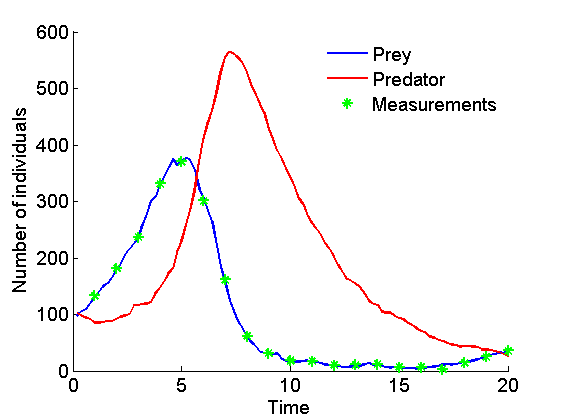
Biips Sensitivity analysis with Sequential Monte Carlo
Parameters of the algorithm
n_part = 100; % Number of particles param_names = {'logc[1]', 'logc[2]', 'logc[3]'}; % Parameter for which we want to study sensitivity n_grid = 20; param_values = {linspace(-7,1,n_grid), repmat(log(c_true(2)), n_grid, 1), repmat(log(c_true(3)), n_grid, 1)}; % Range of values % n_grid = 5; % [param_values{1:3}] = meshgrid(linspace(-7,1,n_grid), linspace(-7,1,n_grid), linspace(-7,1,n_grid)); % param_values = cellfun(@(x) x(:), param_values, 'uniformoutput', false);
Run sensitivity analysis with SMC
out_sens = biips_smc_sensitivity(model, param_names, param_values, n_part);
* Analyzing sensitivity with 100 particles |--------------------------------------------------| 100% |**************************************************| 20 iterations in 3.88 s
Plot penalized log-marginal likelihood
figure('name', 'Sensitivity: Penalized log-marginal likelihood'); plot(param_values{1}, out_sens.log_marg_like_pen, '.') xlabel('log(c_1)') ylabel('Penalized log-marginal likelihood') ylim([-15000, 0]) box off

Biips Particle Marginal Metropolis-Hastings
We now use Biips to run a Particle Marginal Metropolis-Hastings in order to obtain posterior MCMC samples of the parameters and variables  .
.
Parameters of the PMMH
n_burn = 2000; % nb of burn-in/adaptation iterations n_iter = 20000; % nb of iterations after burn-in thin = 10; % thinning of MCMC outputs n_part = 100; % nb of particles for the SMC param_names = {'logc[1]', 'logc[2]', 'logc[3]'}; % names of the variables updated with MCMC (others are updated with SMC) latent_names = {'x'}; % names of the variables updated with SMC and that need to be monitored
Init PMMH
obj_pmmh = biips_pmmh_init(model, param_names, 'inits', {-1, -5, -1},... 'latent_names', latent_names); % creates a pmmh object
* Initializing PMMH
Run PMMH
obj_pmmh = biips_pmmh_update(obj_pmmh, n_burn, n_part); % adaptation and burn-in iterations [obj_pmmh, out_pmmh, log_marg_like_pen] = biips_pmmh_samples(obj_pmmh, n_iter, n_part,... 'thin', thin); % Samples
* Adapting PMMH with 100 particles |--------------------------------------------------| 100% |++++++++++++++++++++++++++++++++++++++++++++++++++| 2000 iterations in 293.14 s * Generating 2000 PMMH samples with 100 particles |--------------------------------------------------| 100% |**************************************************| 20000 iterations in 3455.99 s
Some summary statistics
summ_pmmh = biips_summary(out_pmmh, 'probs', [.025, .975]);
Compute kernel density estimates
kde_pmmh = biips_density(out_pmmh);
param_true = log(c_true);
param_lab = {'log(c_1)', 'log(c_2)', 'log(c_3)'};
Posterior mean and credible interval of the parameters
for i=1:numel(param_names) summ_param = getfield(summ_pmmh, param_names{i}); fprintf('Posterior mean of %s: %.3f\n', param_names{i}, summ_param.mean); fprintf('95%% credibile interval of %s: [%.1f, %.1f]\n',... param_names{i}, summ_param.quant{1}, summ_param.quant{2}); end
Posterior mean of logc[1]: -0.561 95% credibile interval of logc[1]: [-0.7, -0.4] Posterior mean of logc[2]: -6.174 95% credibile interval of logc[2]: [-6.3, -6.0] Posterior mean of logc[3]: -1.512 95% credibile interval of logc[3]: [-1.9, -1.2]
Trace of MCMC samples for the parameters
for i=1:numel(param_names) figure('name', 'PMMH: Trace samples parameter') samples_param = getfield(out_pmmh, param_names{i}); plot(samples_param, 'linewidth', 1); hold on plot(0, param_true(i), '*g'); xlabel('Iteration') ylabel(param_lab{i}) title(param_lab{i}) box off end
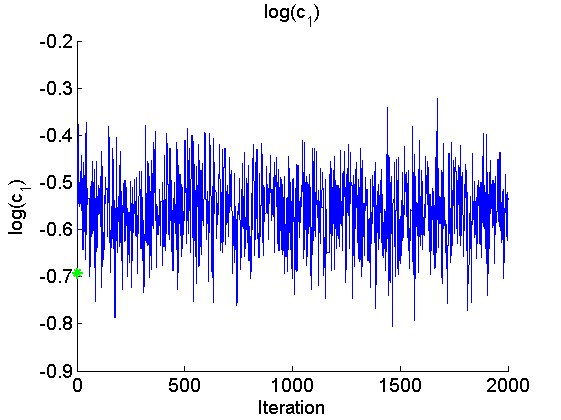


Histogram and KDE estimate of the posterior for the parameters
for i=1:numel(param_names) figure('name', 'PMMH: Histogram posterior parameter') samples_param = getfield(out_pmmh, param_names{i}); hist(samples_param, 15) h = findobj(gca, 'Type', 'patch'); set(h, 'EdgeColor', 'w') hold on plot(param_true(i), 0, '*g'); xlabel(param_lab{i}) ylabel('Number of samples') title(param_lab{i}) box off end for i=1:numel(param_names) figure('name', 'PMMH: KDE estimate posterior parameter') kde_param = getfield(kde_pmmh, param_names{i}); plot(kde_param.x, kde_param.f); hold on plot(param_true(i), 0, '*g'); xlabel(param_lab{i}); ylabel('Posterior density'); title(param_lab{i}) box off end
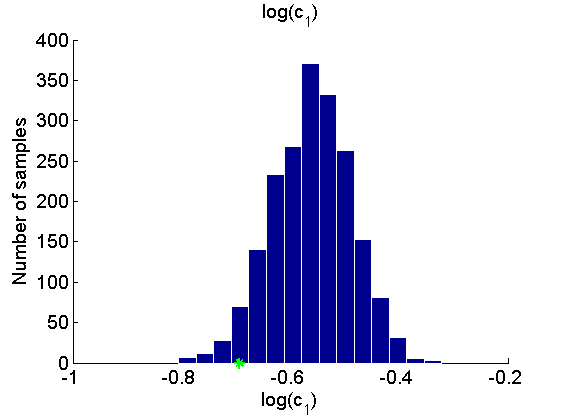
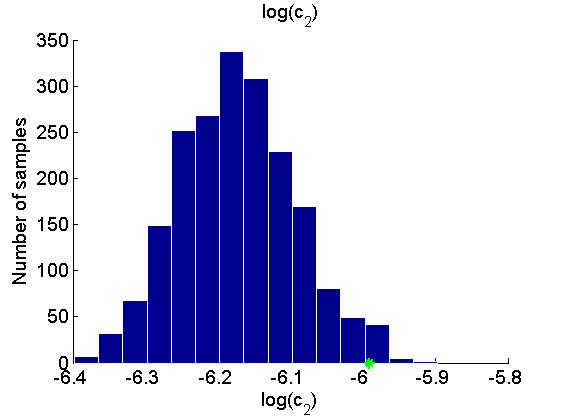
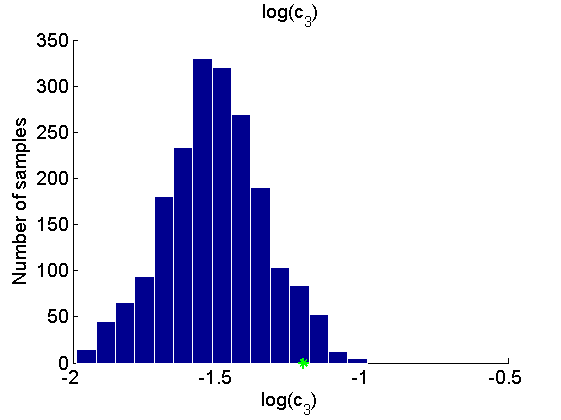
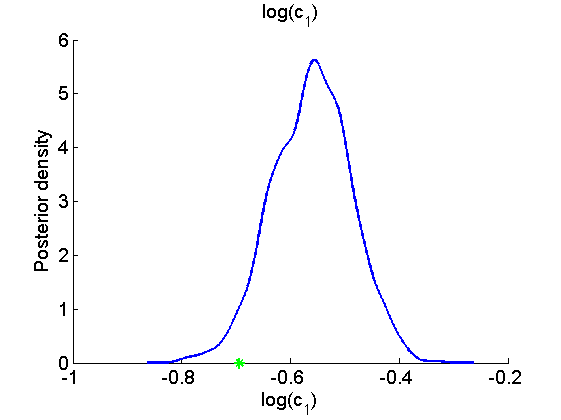
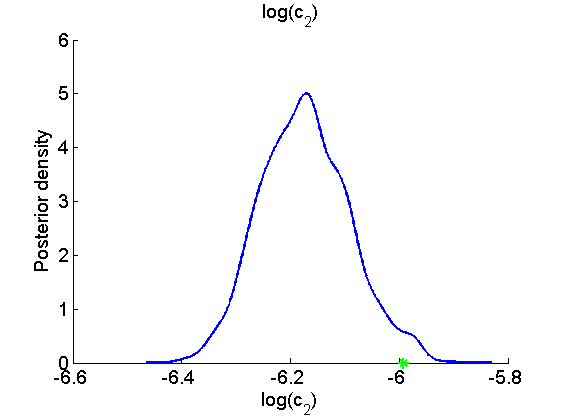

Posterior mean and quantiles for x
figure('name', 'PMMH: Posterior mean and quantiles') x_pmmh_mean = summ_pmmh.x.mean; x_pmmh_quant = summ_pmmh.x.quant; h = fill([t_vec, fliplr(t_vec)], [x_pmmh_quant{1}(1,:), fliplr(x_pmmh_quant{2}(1,:))], 0); set(h, 'edgecolor', 'none', 'facecolor', light_blue) hold on plot(t_vec, x_pmmh_mean(1, :), 'linewidth', 3) plot(t_vec, data.x_true(1,:), '--', 'color', dark_blue) h = fill([t_vec, fliplr(t_vec)], [x_pmmh_quant{1}(2,:), fliplr(x_pmmh_quant{2}(2,:))], 0); set(h, 'edgecolor', 'none', 'facecolor', light_red) plot(t_vec, x_pmmh_mean(2, :), 'r', 'linewidth', 3) plot(t_vec, data.x_true(2,:), '--', 'color', dark_red) xlabel('Time') ylabel('Number of individuals') ylim([0, 1500]) legend({'95% credible interval (prey)', 'PMMH mean estimate (prey)', 'True number of preys',... '95% credible interval (predator)', 'PMMH mean estimate (predator)',... 'True number of predators'}) legend boxoff box off saveas(gca, 'stoch_kinetic_x', 'epsc2') saveas(gca, 'stoch_kinetic_x', 'png')
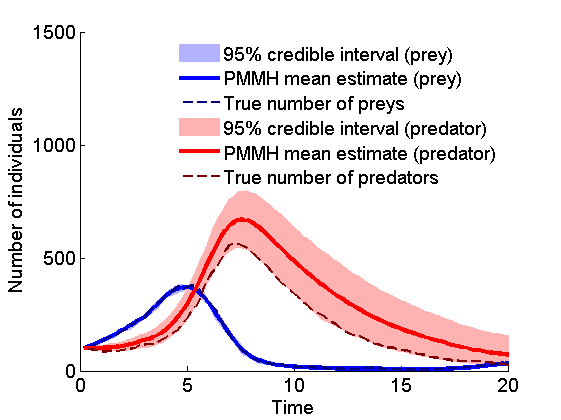
Clear model
biips_clear(model)